“In the Land of the Long White Cloud, Aotearoa, every breath is new life. Seasons change, the winds blow, and family’s love lets the child rise high, look far, dream big. Tomorrow is coming, Mana, and you must run to meet it. Soon you will be a man.”
-Excerpt from HĀ: Breath of Life
“Soon you will be a man.” With this promise, HĀ: Breath of Life begins Act 3. This act showcases Māori culture as we watch Mana’s journey to manhood in the beautiful nation of Aotearoa, also known as New Zealand or the Land of the Long White Cloud.

Mana’s father guides him as he begins his training in Act 3 of HĀ: Breath of Life
We Start with a Kite
This act begins with a inquisitive Mana playing with a kite. Though this kite may look like a great toy, it is far more important and symbolic. This kite was used as a vessel for Karakia, or prayers being sent to the heavens. Comparatively, these kites were actually much larger than the prop shown in the Center’s night show. Due to their size and significance these kites were only to be handled by certain men of the tribe. This is why we see Mana’s father run in to take the string from his son.
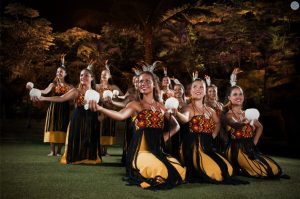
The poi performance showcases the nurturing nature of Māori villagers
Poi Dance
As the nurturers of the Village, Mana’s Mother comes out with the other women to perform the Poi. In the Māori culture Poi is a dance implement, a light ball attached to a cord of varying lengths used to accompany songs or chants that tell their stories. The implement is swung around the body and tapped producing energetic beats and rhythms.
The Poi performed in HĀ is fun and upbeat, dedicated to Mana and his playful ways. This Poi tells of how Mana is always running around, hiding and getting up to mischief. However, at the end of the Poi his Mother hugs him, and reminds him that no matter what, he is loved and cared for.
This reassurance of love and protection from his parents and extended family carries him into the next stage of his life where he learns to be a man.
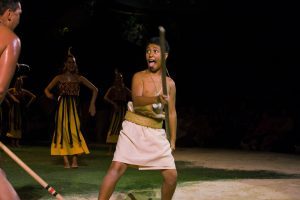
Mana learns the skills of the long pole.
To Train and Grow in Māori Culture
HĀ is set in a pre-European era, where tribes fought for land, power and prestige. The focus was on protection and survival, building strong and powerful war-parties and bringing up strong Village and Tribal leaders. However, the core values remain true and universal; family ties, courage, persistence, and fighting for survival. This warrior mentality drives the training that we see Mana go through as he grows.
Next, we see the warriors of the Village display their skill and strength with the use of a long-staff weapon. They are strong, powerful and impressive as they exercise and drill their footwork and many weaponry strikes, parries and on-guard stances. Mana looks on, longing for the day when he can join the ranks of the warriors.
You will then hear Mōteatea, a traditional chant that the Villagers recite to recognize that Mana is about to start his life-long Training to become a Leader and Warrior. The chant acknowledges all their ancestors and the guidance they continually receive from them.

Māori warriors perform the Haka in HĀ: Breath of Life
Becoming a Man in Māori Culture
We follow Mana’s training throughout the remainder of his adolescence, as the performers begin the Action-song. This contemporary tune is performed with choreographed actions, motions and footwork.
In HĀ, the Action-song highlights Mana’s training. In ancient times, children’s games formed the foundation of warrior skills, so throughout the song you’ll see a combination of games and training with Mana’s Mentors. First, you’ll see Mana learning specific foot-work. This is important as it is the foundation of all warrior skills. Then you’ll see him training with a medium sized stick. Notice how he maneuvers it around his body. This strengthens and gives flexibility to his limbs and torso in preparation for using a weapon. Finally, he graduates to a longer staff and begins his warrior training. In this song the Villagers are not only celebrating his adolescence and training, but they’re also encouraging and supporting him every step of the way.
At last Mana is a man, having completed his training and grown into adulthood. Mana rises as his father places a cloak around him, signaling his new status. Mana then exchanges hongi, the traditional greeting in Māori culture, with his father. This greeting is a pressing of noses and foreheads, symbolizing the sharing of souls and the exchange of HĀ, the breath of life. Mana, now full grown, goes to lead the haka.

The Māori pendant worn during ACT 3 represents the path of life
The Significance of Māori Pendants
As you see Mana’s community rally around him notice that they are all wearing pendants. These pendants have a deep symbolic meaning to the Māori people, providing connection, guidance and protection from negativity.
Some examples of pendants are a Manaia which is representative of a crossing or connection between Earth and the Spirit world. There are also Koruru, often the face or mask of a guardian, but can also represent ancestors or deities. Lastly, a Taniwha, associated with specific places, usually bodies of water; to some they are seen as guardians representing life and giving good fortune.
The pendant worn by performers in the show is a Pikorua (to twist). The twist depicts two new shoots growing together. It is said to represent the path of life and the strong and eternal bond between two people. Like the twist in the design, life for both individuals will continue despite many unexpected twists and turns, inevitably bringing them together again one day. This describes the eternal bond between Mana and his father, but it can also refer to Mana’s connection to his family, his people, and his transition from boy to manhood.

The Haka showcases the strength, power and support of the Māori people.
The Power of Haka
Mana, now a Leader of the Village, leads the final item, the Haka. Haka is a male posture dance which in the Māori Culture is a powerful display of unity and strength. Anciently the Haka was expressed in times of war. It was ferocious, intimidating and very powerful. However, now not all Haka are done out of defiance.
Today Haka are performed to acknowledge all aspects of life, including times of anger and defiance and also beautiful and special occasions. Regardless of when or where they’re performed, Haka are always powerful, strong and can even look intimidating.
The Haka in HĀ is a Haka of peace and guidance. It is done to honor Mana. It is encouraging him to move forward, to live a noble life without giving in to hatred, jealousy and all the negativities of life. The Village welcomes Mana into manhood and sends him into the next phase of his life which they helped prepare him for, a future that is always fast approaching.
HĀ: Breath of Life Act 3 showcases the beauty and strength of Māori culture and, as was promised, Mana is now a man.
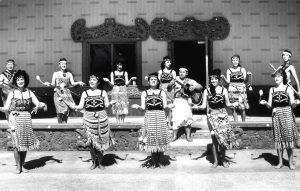
Black and white image of female performers showcasing the ‘poi” at the Māori Village at the Polynesian Cultural Center.
The Strength of the Māori
A popular Māori proverb conveying strength says: ‘ehara taku toa i te toa takitahi, he toa takitini’ – my strength is not as an individual, but as a collective.
The Māori people commit themselves to their family and their community. They are known for their courage and might. Also, for their great love for one another, for the land, and for the life granted to them. We gratefully share the beautiful Māori culture at the Center and in this overview of Act 3 of HĀ: Breath of Life.
Want to learn more about the the other acts in HĀ: Breath of Life? Then…
Read our deep dive into Act One to learn more about Tongan Culture.
Read about the Aloha culture of Hawaii showcased in Act Two
Enjoy some of our most popular blogs about Māori culture, including recipes, history and travel
Honoring the Māori Language Through Inspired Quotes – polynesia.com | blog
The Village Approach: Māori Child Rearing – polynesia.com | blog
Maoritanga – The Maori Way of Life – polynesia.com | blog
Like the Maori: Thin the Veil Between You and Your Ancestors – polynesia.com | blog
Ta Moko: Maori Tattooing – polynesia.com | blog
Review our extensive library of blogs covering various aspects of this and other Polynesian cultures at Cultures of Polynesia Archives – polynesia.com | blog
Bio of Nina S. Jones, Blogger for the Polynesian Culture Center
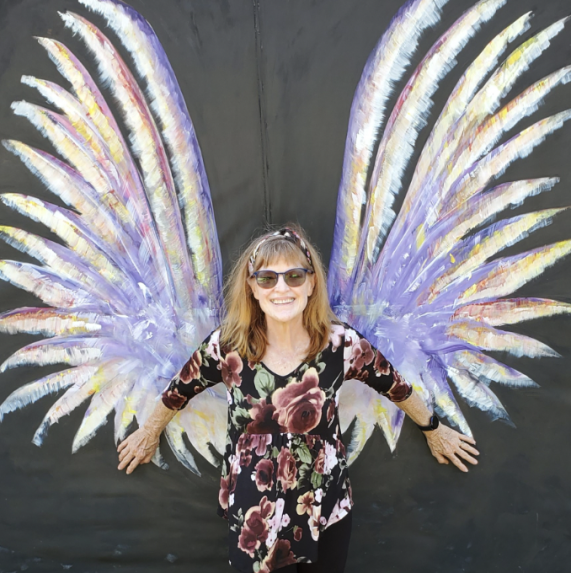
Nina Jones, a mainland gal from way back, is now a transplanted Islander. With her husband of 39 years, she volunteers at the Polynesian Cultural Center. Her hobbies include swimming, traveling, studying and writing about what she is learning from the various Polynesian cultures. Her blogs focus on their history, beliefs, practices and – as an added bonus – delicious food! To her, Polynesia is not just a place to visit, it is a way to live and she is very honored to be able to be a part of their amazing world.

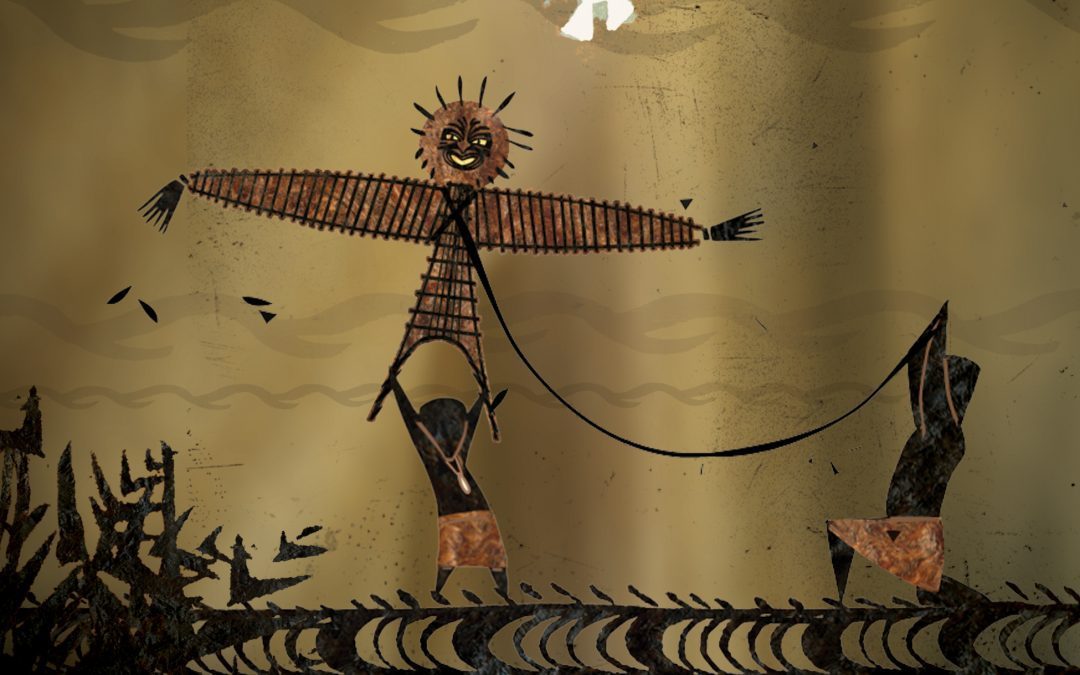
Recent Comments